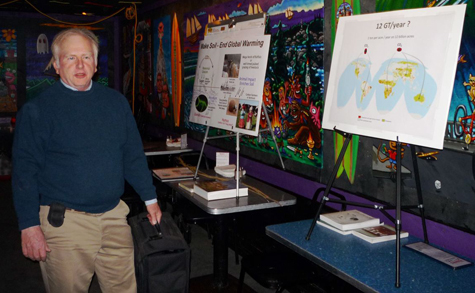Submitted on
Under the influence of Michael Pollan and others, I've written previously about how we've lost the connection between the food we eat and the world that produces it.
I don't know which should strike you as more absurd, that such a disconnect could occur, or that I could be the one mentioning it, again — I'm suburban all the way, a middling house-plant grower at best, and until recently, didn't even understand what other people meant by having a connection to the land.

And yet, here I am again, brought along this time by Jim Laurie, whom I heard speak Tuesday night at Redbones BBQ in Somerville, which I take pain to mention because they've been strong community supporters as long as they've been around. On Tuesday, they hosted the Mass. Climate Action Network, serving grass-fed beef donated by Chestnut Farms of Hardwick.
Laurie is a biologist whose message, in part, is "make soil, end global climate change." To get the fullness of his ideas, you can go to groups.google.com/groups/soil-age. What follows is just some writer's attempt to convey the thoughts of someone who knows what he's talking about:
In so many ways, modernity has broken down something natural, especially around food, and then re-engineered it in ways that produce profits but aren't necessarily good in the larger sense. Think "enriched white bread," or "cheese food."
Glaring examples that Laurie cited in his talk included grain-fed beef and chemical-fertilizer-driven farming. Before man "fixed" the system, beef, buffalo, and other ruminants ate their way across great grasslands, taking in calories grown from the sun above and the earth below. While in one spot, the animals' hooves would break up the surface, allowing water into the land below, and their droppings were fertilizer. When the grasses had been in eaten in one place, the animals would move on. By the time they'd return, the sun and the earth and the fertilzer would have regenerated the grasses. The soil would be richer than on the animals' last pass through.
Now, of course, agribusiness grows the corn in one place (well, practically every place), using chemical fertilizers that degrade the soil over time, rather than improving it. Then they truck the feed to huge lots where the animals live gross, completely objectified existences in which the ground is little more than excrement-laden mud, and the feed suits the feeders but not the eaters,
As I learned principally from Pollan's "Omnivore's Dilemma," which Laurie mentioned repeatedly, one of the vet's key tools on the feedlot is a hose, used to stick down the throats of cows stricken by the buildup of methane in one of their stomachs. If not vented in time, the pressure will kill them. Additionally, of course, animals' living in excrement requires a constant diet of antibiotic drugs. And while on a grass plain, the manure has a welcome role in the process, at feedlots it goes into lagoons and festers, becoming a major source for hydrogen sulfide and methane, a greenhouse gas 23 times more potent than CO2.
Most of this is, of course, background. Laurie's contention is that soil building is the best short-term hope for keeping carbon out of the atmosphere.
On the soil-age website, Laurie and partner Seth Itzkan say that "returning atmospheric CO2 to 310 ppm [it's now at 385 and rising 2-3 ppm a year] would require removing 150 gigatons of carbon from the air. There is enough land to sequester this carbon and it could be done in a decade or two."
Laurie gave a couple of examples of what happens when a farmer attempts to transform his process and his land. One was the story of Tony and Jerrie Tipton of Nevada, who turned a huge mound of waste earth from gold mining, on which nothing would grow, into a picture of verdant green grass. Essentially, they accomplished the task in four days of putting down bales of hay and bringing in cows to eat it. The cows not only ate but trampled: Hooves planted hay debris into the hard, dry earth, and created fissures that allowed water and nutrients to seep in.
Then the cows were removed, and they waited. By the end of summer, the wasteland was waist deep in green grass, created with just 6 inches of rain. (Read a far better account of it.) There wasn't a single bad outcome from the effort.
Laurie also told tales about Abe Collins, a Vermont farmer he said is "an evangelist for soil-making." Collins is "putting down 6 tons of carbon per acre per year," Laurie said, but added that he's also seeking funding for an academic study to document the full range of results from his methods.
Other links related to these topics:
Photo by Seth Itzkan
- Michael's blog
- Log in to post comments